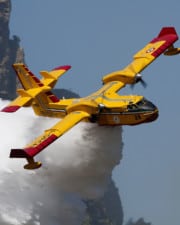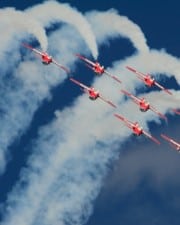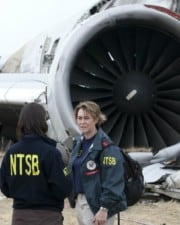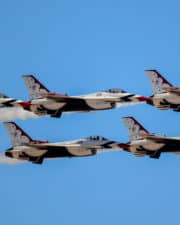The story of the Spruce Goose is a part of aviation lore that everyone should know. Like the story of the ill-fated HMS Titanic, it’s a story of the problems with making something that holds the title of “world’s largest.”
If you were alive in the mid-1940s, you would know the name Spruce Goose. It would be like SpaceX or Blue Origin today. These are the news-making, ground-breaking projects of our time, pushing the bounds of what we believe we can do in the field of aerospace.
And like these rocket companies with big goals, the Spruce Goose was the dream of a famous billionaire. While SpaceX is Elon Musk’s project, and Jeff Bezos’ bankrolls Blue Origins, the Spruce Goose was the brainchild of the singular Howard Hughes.
While we don’t know how the SpaceX or Blue Origins sagas will end, Hughes’ giant seaplane program from the 1940s is well-documented. Here’s a look at this fantastic aircraft, why it was built, and what happened to it.
What is the Spruce Goose?
Possibly one of the most famous aircraft of all time, the Spruce Goose was the monumental achievement of Howard Hughes and his Hughes Aircraft Company.
The eight-engined, propeller-driven, wooden seaplane was world-famous at the time of its building and launch. For decades, the plane remained the largest aircraft ever built or flown.
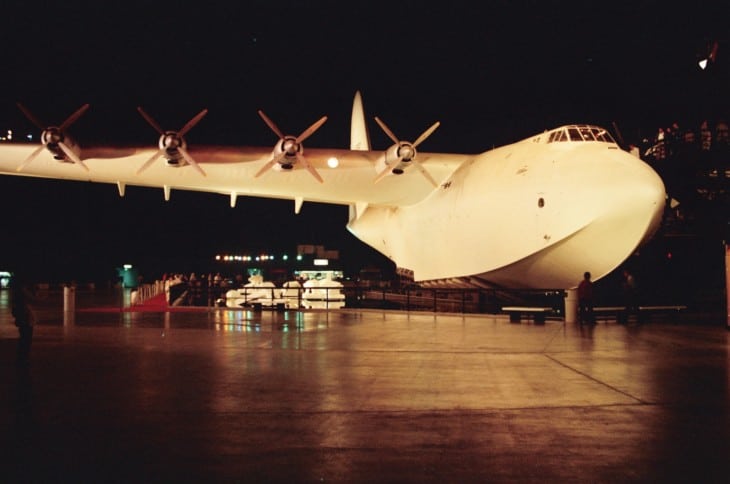
The name “Spruce Goose” was a nickname given to the plane by the media, and not with admiration. Its proper designation is the Hughes H-4 Hercules, although it was originally called the HK-1 Hercules. Hughes reportedly hated the nickname.
Who Built the Spruce Goose and Why?
Hughes Aircraft Company built the H-4 in the 1940s under a military contract for the US government.
Hughes Aircraft was owned by Howard Hughes, a world-famous pilot and billionaire businessman of the time. You might remember the story of Hughes from the biopic The Aviator (2004), starring Leonard DiCaprio.
Hughes had a penchant for aviation, having started in Hollywood making films like Hell’s Angels (1930) and going on to set the world airspeed record in 1935 with the Hughes H-1 Racer.
The purpose of the H-4 Hercules was to meet the need for a heavy troop and equipment-carrying aircraft that could fly across the Atlantic. The war in Europe meant that the US needed to transport lots of troops and equipment to Britain, and shipping in the North Atlantic was taking a heavy hit from German submarines.
A secondary goal of the program was to build the aircraft using materials that didn’t take away from other war machines. Unfortunately, aluminum, the traditional choice for building large aircraft, was in particularly low supply.
Even though Hughes built the plane, it was conceived and designed by Henry J. Kaiser. Kaiser was a builder of Liberty ships–transport ships built quickly and en masse during World War II.
In many ways, the Hughes H-4 was similar to how the shipping industry used alternative materials when steel was in short supply, like ferro-cement vessels (aka concrete ships), built during the height of the war.
When was the Spruce Goose Built?
Construction of the plane began in 1942, during the height of US involvement in World War II. The design of the aircraft was extremely ambitious.
Building the plane took much longer, and much more money than Hughes ever expected. By the time the plane was ready to fly, the war was over. Howard Hughes had staked his reputation on the plane and faced enormous criticism.

The plane was built on contract for the US government, and Hughes’ critics believed the entire program to be a boondoggle, a waste of resources and taxpayer dollars.
The plane’s name, “Spruce Goose,” was a tongue-in-cheek jab at the plane and the man behind it. Howard Hughes appeared before Congress several times to defend the plane and his plan.
It didn’t help that progress on the project proceeded slowly, and the plane wasn’t completed until late 1947. In the end, the plane cost more than $23 million to build, about $278 million in today’s dollars.
What was the Spruce Goose Made Of?
The huge aircraft was made entirely of wood. This choice might seem unconventional by today’s standards, and it was revolutionary to consider building such a large plane this way at the time.
But Hughes faced several hurdles in building the H-4, not the least of which was the wartime limits placed on traditional materials like aluminum.
There were also concerns about the overall weight of the finished plane. While the plane needed to be enormous to transport as much material as possible across the Atlantic, it also needed to be lightweight. The lighter the plane’s empty weight, the more payload it could carry.
Today, plastic composites like fiberglass or carbon fiber are used to meet these goals. But in 1940, neither of these things existed, so wood was used to build the plane. And, despite its nickname, it was actually made of birch (not spruce).
But saying the plane is built out of wood is an oversimplification. The wood is a laminated plywood product called Duramold, a special process that strengthens and shapes wood panels.
Duramold is similar to plywood. Thin birch or poplar plys are soaked with a resin (plastic). Pieces are then laminated together inside a mold under high temperatures, as much as 280 degrees Fahrenheit.
Virginius Clark developed the Duramold process for Fairchild Aircraft. It was used on several light aircraft designs, including the Fairchild F-46.
At the time, Duramold was a major technological innovation that produced components as strong, if not stronger, than their aluminum counterparts.
Hughes was so committed to using Duramold for the plane that he bought the rights to the Duramold process from the company for aircraft over 20,000 pounds.
The H-4 was the largest aircraft made with the process, and it used the process for everything. The only parts of the plane that aren’t made from wood are the engines, electronics, and screws.
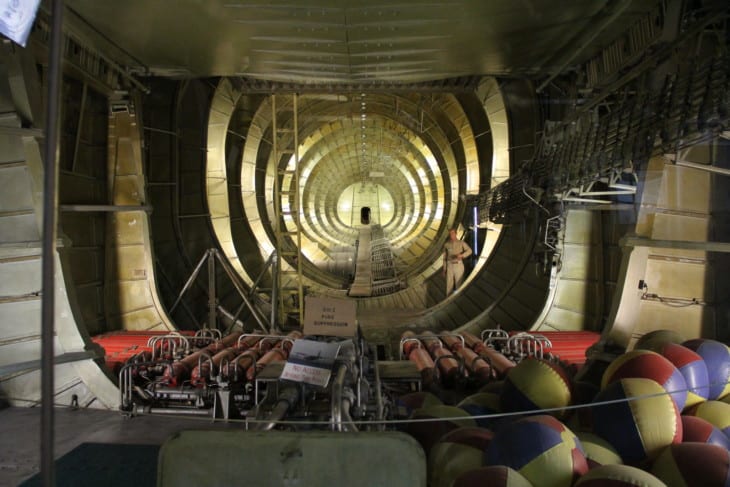
Duramold, Haskelite, and Aeromold were all similar technologies that emerged in the late 1930s and 40s. In addition, de Havilland Aircraft used similar composites in the DH.88 Comet, Mosquito, Vampire, and DH.91 Albatross.
These wood composites were a segway into the composites of today, which are used extensively on modern aircraft.
While Duramold proved inadequate for heavy aircraft use, modern composites made with resin-infused glass or carbon fibers make up a majority of new planes like the Airbus A350 and Boeing 787 Dreamliner.
How Big Was the Spruce Goose?
If the H-4 Hercules has one claim to fame, it is that it’s big!
The Spruce Goose remains one of the largest aircraft ever built. While it has been surpassed over the years in terms of wingspan, length, height, and weight, it is still the largest seaplane, the largest wooden plane, and the largest propeller-driven plane ever.
Hughes H-4 Hercules Specifications
| Length | 218 feet, 8 inches | 66.65 meters |
| Wingspan | 320 feet, 11 inches | 97.82 meters |
| Height | 79 feet, 4 inches | 24.18 meters |
| Empty Weight (approx.) | 300,000 pounds | 113,398 kg |
| Max Takeoff (approx.) | 400,000 pounds | 181,437 kg |
Spruce Goose Size Comparison
To this day, the Spruce Goose is compared with the largest planes flying in the sky. It’s still in the top five, no matter how you tally the dimensions.
During an appearance before the US Congress in 1947, Howard Hughes described the plane thusly.
“The Hercules was a monumental undertaking. It is the largest aircraft ever built. It is over five stories tall, with a wingspan longer than a football field. That’s more than a city block.”
Howard Hughes, 1947
What is the Wingspan of the Spruce Goose?
For over 50 years, the Spruce Goose was the aircraft with the longest wingspan.
Part of this was owing to its straight wings. Larger modern jets had swept-back wings with shorter overall wingspans. So while newer planes like the Boeing 747 were far heavier and carried more payload, their wingspans were actually shorter.
The wingspan of the H-4 Hercules is greater than that of the Boeing 747 and Airbus A380, and even bigger than the Antonov An-225 Mira.
In fact, the Spruce Goose had the longest wingspan of any aircraft until 2019, with the launch of Scaled Composites’ Stratolaunch aircraft.
Aircraft by Wingspan
| 1 | Stratolaunch | 385 feet | 117 meters |
| 2 | H-4 Hercules “Spruce Goose” | 320 feet, 11 inches | 97.82 meters |
| 3 | Antonov An-225 | 290 feet | 88.4 meters |
| 4 | Airbus A380-800 | 261 feet, 8 inches | 79.75 meters |
| 5 | Boeing 747-8 | 224 feet, 7 inches | 68.45 meters |
https://commons.wikimedia.org/wiki/File:Stratolaunch_comparison.svg
Aircraft by Length
In terms of length, the Spruce Goose is shorter than its “largest aircraft” compatriots. Even the original Boeing 747-100 was longer than the H-4.
| Antonov An-225 | 275 feet, 7 inches | 84 meters |
| Boeing 747-8 (Launched 2010) | 250 feet, 2 inches | 76.25 meters |
| Airbus A340-600 | 247 feet | 75.3 meters |
| Boeing 777-300 | 242 feet, 4 inches | 73.86 meters |
| Airbus A380-800 | 238 feet, 7 inches | 72.72 meters |
| Stratolaunch | 238 feet | 72 meters |
| Boeing 747-100 (Launched 1969) | 231 feet, 10 inches | 70.7 meters |
| Boeing 787-10 Dreamliner | 224 feet | 68.28 meters |
| H-4 Hercules “Spruce Goose” | 218 feet, 8 inches | 66.65 meters |
Note: Table incomplete, several other aircraft have surpassed the Spruce Goose in terms of total length.
How Many Motors Did the Spruce Goose Have?
Shear scale is only one descriptor for size, of course. The Spruce Goose needed a lot of power to lift its massive body off the water. It was designed and built before the dawn of the Jet Age, so its engines are conventional radial engines that turn four-bladed propellers.
Hughes used the biggest, most powerful engines he could find–the Pratt and Whitney R-4360 Wasp Major. These 28-cylinder radial engines were air-cooled pistons spinning four-blade Hamilton Standard propellers, each 17 feet in diameter.
But to get enough power, the H-4 had to use eight of them! With 3,000 horsepower each, the entire plane had a total of 24,000 horsepower.
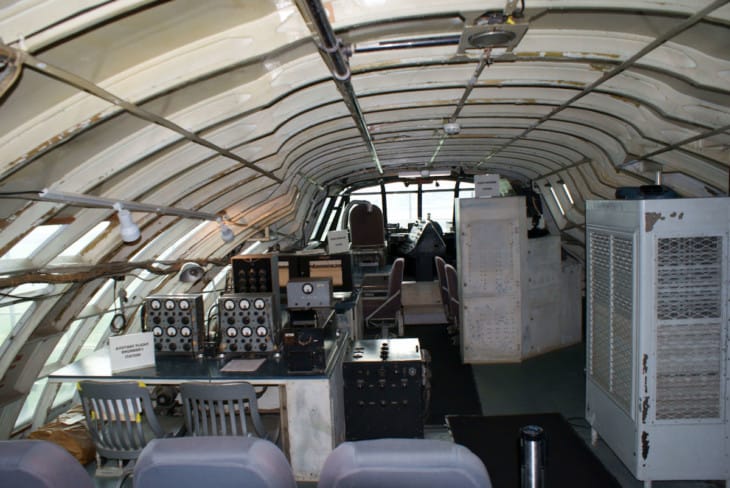
Why Did the Spruce Goose Only Fly Once?
With the end of the war and waning government support, the Spruce Goose was doomed before it ever took flight.
But Howard Hughes was a driven man who had staked his reputation on the plane. After returning to California from testifying before a critical Congressional committee in 1947, he went to perform taxi tests in the aircraft. The goal was to move the plane around the harbor and ensure it handled on the water correctly before proceeding to the flight testing phase.
The plane wasn’t just big–it was big news. A crowd of media was on hand to watch the taxi tests, including a group of reporters onboard the plane.
Hughes knew that support for the project was waning and that it was likely to be shut down soon. He couldn’t face the idea that Hercules might never fly, or worse, proving his opponents correct in their belief that it never could.
On the last test run of the day, Hughes lifted the aircraft off the water to the surprise of all observers. Of course, the flight wasn’t an accident–Hughes knew that thousands of spectators had lined up in the harbor, and the news media was covering the taxi tests.
In this day and age, the flight would be labeled a publicity stunt. But Hughes managed to turn the tide on public support and wowed his audience that day. It didn’t change the economic facts, of course. But it changed public perceptions and boosted Hughes’ reputation.

Here are the answers to the top questions about that historic flight on November 2, 1947.
How Long Did the Spruce Goose Fly?
The Spruce Goose’s one-and-only flight lasted 26 seconds and covered only about half a mile.
How High Did the Spruce Goose Fly?
The plane only made it about 25 feet off the water’s surface in its short flight. At that altitude, the plane was still well within ground effect.
Who Piloted the Spruce Goose?
Howard Hughes himself flew the plane on its only flight. Arguably, the flight wouldn’t have happened if any other test pilot had been at the controls.
Also onboard the aircraft were his copilot and four other flight crewmembers, 16 mechanics, and 12 guests from the press and aerospace industry.
How Far Did the Spruce Goose Fly?
The Hercules only covered about a half mile in its 26-second flight, never leaving the harbor.
Where Did the Spruce Goose Fly?
The Spruce Goose was performing taxi tests in Long Beach Harbor, near Los Angeles, when it lifted off on its one and only flight.
What was Wrong With the Spruce Goose?
The H-4 Hercules program faced numerous technological and monetary hurdles. It was a massive undertaking, and Howard Hughes staked his personal and professional reputation and fortune on the plane’s success.
But the plane was a victim of history more than anything else. By the time the prototype aircraft was complete, World War II had been over for two years. The plane had been designed for a specific mission, with war shortages in mind. Both the mission and shortages were no longer pressing issues.
Furthermore, other advances were happening in the aviation world. For example, jet engines were being developed that promised to revolutionize the industry.
Why Was the Spruce Goose a Failure?
Overall, whether the program was a failure or a government boondoggle is debatable. Howard Hughes faced his share of criticism at the time of its construction.
In reality, the program did meet its stated goals of providing an operational aircraft suitable for the mission–it just took too long and cost too much.
The Spruce Goose flew only one time, and no more of the aircraft were ever made.
And while the Spruce Goose was impressive, mass production of such a large craft was never really an option. The wood laminate technology would’ve been too expensive and time-consuming to use and would lead to more problems than conventional aluminum airframes.

What Happened to the Spruce Goose?
After its flight in Long Beach Harbor, the H-4 Hercules was kept ready and waiting at Howard Hughes’ instructions.
The plane was kept safe by a specially shaped, climate-controlled hanger right on the harbor. A team of 300 mechanics kept it perfectly airworthy at the cost of $1 million per year. That number was reduced to 62 workers by 1962.
When Howard Hughes died in 1976, the support team was disbanded, and the hanger lease expired. It looked like the plane would meet a grim fate.
Ownership of the aircraft was disputed since the US government had funded its construction. In the 1970s, the Summa Corporation (a holding company of the Hughes estate) agreed to part out the plane and donate parts to the Smithsonian Air and Space Museum.
But the plane was saved by a devout group of aviation enthusiasts. In the 1980s, the Aero Club of Southern California became the owner and put the plane on display in Long Beach, California.
An enormous geodesic dome was constructed on the harbor adjacent to the Queen Mary. It was climate controlled to protect the plane and eventually became a recognizable feature of the city’s skyline. Locals called it the Spruce Goose Dome.
For years, the attraction drew tourists that came to see the enormous plane. Displays about the plane’s construction and Howard Hughes’ life were set up. Convention groups used the space for large dinners, and concerts were even held inside.
The Walt Disney Company acquired the dome and the Queen Mary in 1988 as part of a planned larger attraction called Port Disney. Unfortunately, that plan was scrapped in 1991, and Disney notified the Aero Club that they no longer wished to display the Spruce Goose.
The dome is still in Long Beach but is now used as a cruise ship terminal.

Where is the Spruce Goose Now?
The Aero Club worked to find a suitable venue for the plane, eventually partnering to transport the plane to the Evergreen Aviation and Space Museum in McMinnville, Oregon.
The actual move of the plane was a logistical feat that involved complete disassembly and moving the big pieces by barges by sea and trucks and trains by land. After transport, the plane was reassembled in its new hangar and completely restored.
Where is the Spruce Goose? You can visit her any time you like since she’s now on permanent public display at the Evergreen Aviation and Space Museum in Oregon. The plane is the museum’s centerpiece and worth a visit for any aviation enthusiast.
Related Posts



